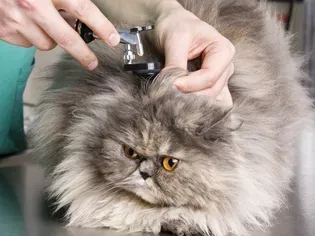Ear Infections in Cats
Updated on 04/26/24

Ear Infections in Cats: A Comprehensive Guide to Diagnosis, Treatment, and Prevention
Ear infections, also known as otitis, are a common medical condition affecting cats of all ages and breeds. Understanding the causes, symptoms, and treatment options can help cat owners effectively manage and prevent this distressing issue. This comprehensive guide delves into the complexities of ear infections in cats, providing valuable information for every feline guardian.
Understanding Ear Infections: A Deeper Dive
Ear infections are primarily divided into three categories based on their location:
1. Otitis Externa (External Ear Infection): This type affects the outer ear, including the pinna (ear flap) and external ear canal. It is commonly caused by ear mites, bacterial infections, or allergies.
2. Otitis Media (Middle Ear Infection): This less common infection affects the middle ear, located behind the eardrum. It can arise from an untreated external ear infection, trauma, or underlying medical conditions.
3. Otitis Interna (Inner Ear Infection): The rarest and most severe type of ear infection, it affects the inner ear, responsible for hearing and balance. It can result from severe bacterial infections, certain viruses, or trauma.
Recognizing the Symptoms: Telltale Signs of Ear Infections
Timely detection is crucial for effective treatment. Common symptoms of ear infections include:
* Excessive head shaking or scratching at the ears
* Discharge from the ear canal (yellow, brown, or bloody)
* Odor from the ears
* Pain or discomfort when the ears are touched
* Inflammation, redness, or swelling of the ear flap and canal
* Loss of balance or coordination (in severe cases)
Causes: Unraveling the Underlying Factors
Various factors can trigger ear infections in cats, including:
* Ear mites: Tiny parasites that live in the ear canal, causing irritation and inflammation.
* Bacterial infections: Often secondary to an underlying ear mite infestation or trauma.
* Allergies: Environmental or dietary allergens can cause inflammation and increase the risk of infection.
* Trauma: Injuries to the ear, such as a scratch or puncture wound, can create an entry point for bacteria.
* Underlying medical conditions: Diabetes, hyperthyroidism, or immune deficiencies can weaken the immune system and increase susceptibility to ear infections.
Diagnosis: Establishing a Clear Picture
Accurate diagnosis is essential for effective treatment. Veterinarians typically rely on:
* Physical examination: Inspection of the ears for discharge, redness, and discomfort.
* Otoscopy: Use of an otoscope to visualize the ear canal and eardrum for abnormalities.
* Cytology: Microscopic examination of ear discharge to identify bacteria, ear mites, or other abnormalities.
* Culture and sensitivity: Bacterial culture to determine the specific bacteria responsible for the infection and assess its susceptibility to antibiotics.
Treatment: Restoring Your Cat's Ear Health
Treatment options vary depending on the type and severity of the infection:
* Ear mite infestation: Topical or oral medications to kill ear mites and clean the ear canal.
* Bacterial infections: Topical or oral antibiotics to eliminate bacterial infection.
* Allergies: Identifying and avoiding triggers, antihistamines, or steroids to control inflammation.
* Underlying medical conditions: Treating underlying health issues to improve immune function and reduce the risk of recurring infections.
Prevention: Proactive Measures for Ear Health
Implementing preventive measures can significantly reduce the incidence of ear infections:
* Ear cleaning: Regular (weekly or monthly) ear cleaning helps remove debris and prevent infections.
* Parasite control: Regular use of flea and ear mite preventatives kills parasites that can cause ear infections.
* Allergy management: Avoiding known allergens and using appropriate medications can prevent allergic reactions that lead to ear inflammation.
* Physical examination: Annual or semi-annual veterinary check-ups allow for early detection and treatment of underlying health conditions.
Conclusion: The Importance of Understanding Ear Infections
Understanding ear infections in cats is vital for all feline guardians. Early detection and treatment can significantly improve a cat's comfort, prevent complications, and ensure overall well-being. By recognizing the symptoms, understanding the causes, and implementing preventive measures, cat owners can proactively safeguard their feline companions from the discomfort and potential consequences of ear infections.
Explore More Pets

Cat Behavior Problems
How to Stop Aggression in Kittens

Long-Haired Cat Breeds
Siberian Cat: Breed Profile, Characteristics, & Care

Cat Behavior Problems
How to Stop Kittens From Scratching and Biting

Long-Haired Cat Breeds
Turkish Angora: Cat Breed Profile, Characteristics & Care

Basic Training
How to Socialize Your Kitten

Short-Haired Cat Breeds
Cute Pictures & Facts About Calico Cats & Kittens

Litter Box Training
Training Your Kitten to Use the Litter Box

Long-Haired Cat Breeds
10 Fun Facts About White Cats